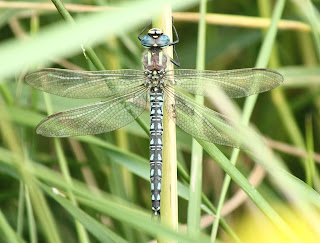With introductions in the East Midlands and large numbers west of London, it has become annual of late and will surely establish a population in Essex in the near future.

What was unexpected though, was a superb Golden Oriole that flew along our hedge and carried on to some tall trees on the edge of the village. Three days later, it or another was reported on the edge of the Priory not a great distance from here.
With the increase in daytime temperatures the first of the Odonata (Dragonflies and Damselflies) have started to appear. Invariably the first of these is the Hairy Dragonfly, aptly named for the fine hairs that cover the thorax. It can often be seen patrolling along Blackthorn hedges when the sun appears.
One of the most obvious dragonflies on warm sunny days is the Emperor, the males being most evident, patrolling over open water, sometimes at several metres above the surface then dropping down to the water to expel other males and dragonflies of other species from its territory. The female can be seen ovipositing (egg laying) some way out from the waters edge.
Two more species that share the same ponds as the Emperor are Broad-bodied Chaser and Black-tailed Skimmer. Both these species benefit from open areas on which they often spend long periods perched sunning themselves.
Often the last species to be on the wing, the Migrant Hawker can be seen well into the autumn. Now well established in the south east, this was an uncommon visitor up until the 1940's, as its name suggests numbers are often boosted by migrants in late summer.
We are fortunate in having two uncommon damselflies on the farm. The first of these is the Small Red-eyed Damselfly, a species that was new to Britain in 1999, incidentally that first record was in Essex !
This damselfly enjoys shallow ponds with a good covering of floating vegetation.
The second is the Scarce Emerald Damselfly, a species that possibly became extinct in Britain, and again rediscovered in Essex. It is similar to the more widespread Emerald Damselfly, but can told apart by only having the powdery blue 'pruinescence' on the first one and a half abdominal segments. Also the inferior apical appendages on the male are broad and curved. They frequent the often brackish ditches that transverse the fields inside of the sea walls. These sites are often covered in Sea club-rush, which appears to be a factor in their success.











































